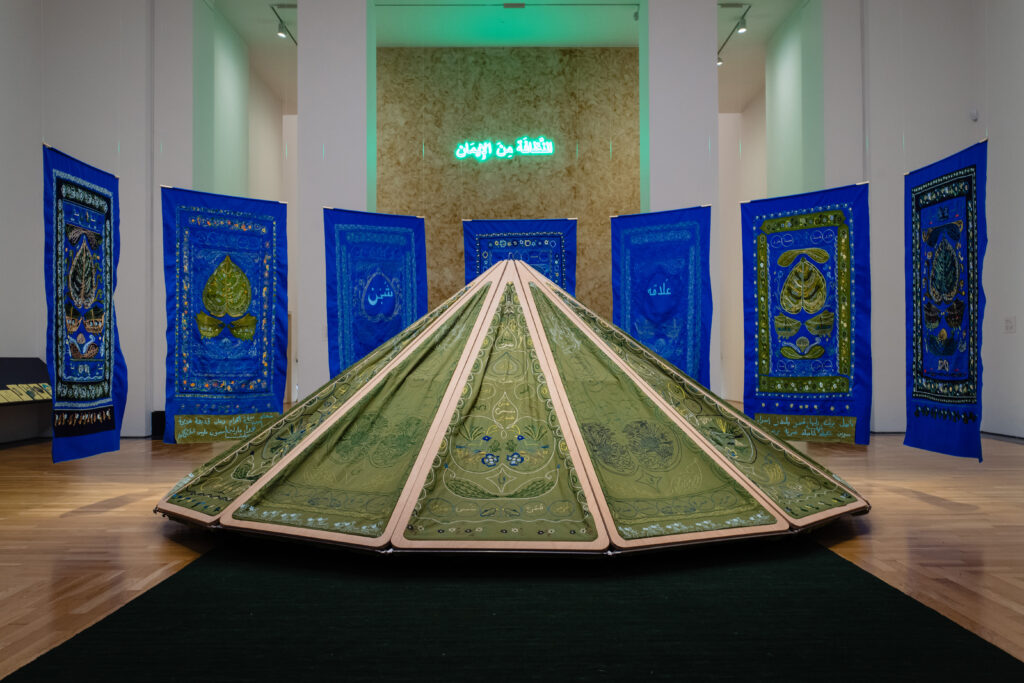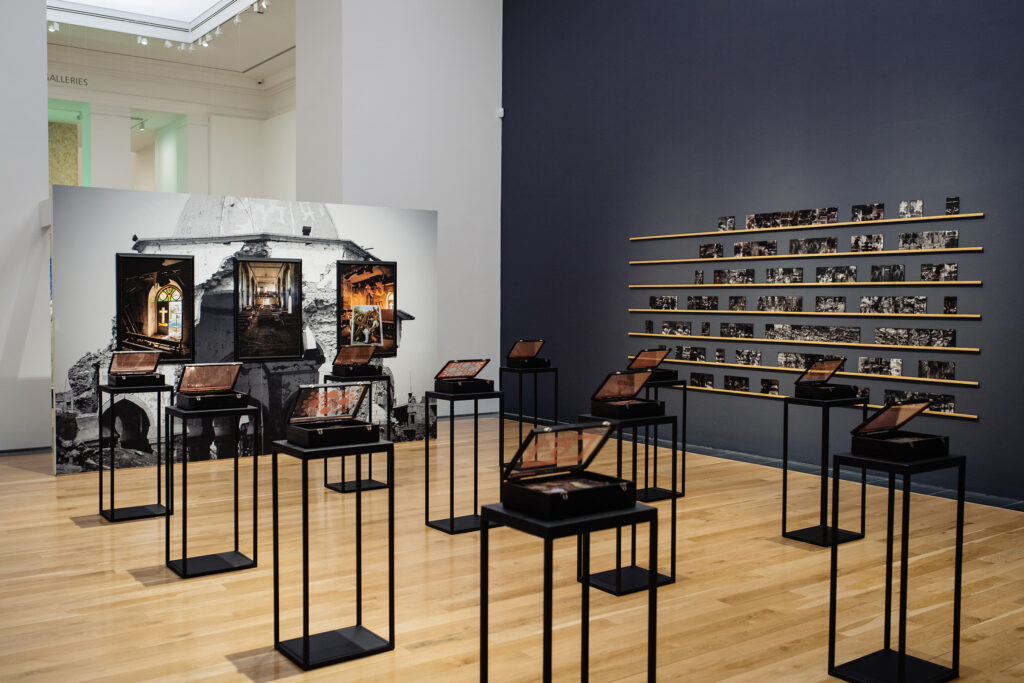World view | Artes Mundi, various venues

If audience engagement is anything to go by, Artes Mundi should be a runaway success, with the tenth edition of this biennial arts prize and exhibition (AM10) expanding beyond Cardiff for the first time.
There are seven shortlisted artists and visitors can see their work at the Glynn Vivian art gallery, Swansea; Oriel Davies Gallery, Newtown; and Mostyn, Llandudno; as well as Chapter and the national museum in the capital. Previous editions have just been shown at one or two venues in Cardiff.
AM10 should also have a big impact because of the topics that the participating artists have chosen to focus on. Ever since it was established in 2002, the prize has been committed to working with artists whose work engages with social reality and lived experience.
But it feels like this edition has a particularly strong focus on some key global topics, particularly the environment, human migration and indigenous rights.
Presenting the work of seven artists across Wales has both curatorial and logistical challenges, including how to make the offer coherent and meaningful across a broad range of venues.
The exhibition and prize is developed by an open call that gets a huge response. From this, the judges have to choose a programme that fits the aims of Artes Mundi and has relevance not only to Wales but internationally as well.
This year’s artists come from different backgrounds and have a wide range of interests. But all of them address social, environmental and political issues with works that often represent angry and urgent reactions to injustice around the world.
Carolina Caycedo is a multidisciplinary artist known for her videos, books, sculptures and installations that examine environmental justice, social issues and indigenous rights.
Her work at Oriel Davies includes more than 100 portraits of female environmentalists from across the world. Caycedo says the work, called My Female Lineage of Environmental Struggle (2018 to present), includes many people who have been killed, imprisoned or disappeared for their activism.
Enjoying this article?
This area of Museums Journal is normally just for members. Join the MA to get full access to the latest thinking and trends from across the sector, case studies and best practice advice.
The artist, who was born in the UK to Colombian parents and now lives and works in the US, has been inspired by the Greenham Common women’s peace camp, a series of protests in that started in the 1980s in response to plans to store nuclear weapons at the Royal Air Force based in Berkshire. The exhibition features a selection of original Greenham Common banners from UK collections.
Some of the women who took part in the activities at Greenham Common are included on the My Female Lineage of Environmental Struggle textile banner.
Caycedo is also showing Fuel to Fire: Mineral Intensive (2022 – ongoing) at Oriel Davies, a large-scale coloured pencil drawing from an ongoing series that focuses on extraction practices and their impact on the land. There is also a related video work, Fuel to Fire (2023).
One of the things that marks Caycedo’s approach to her work, and is shared by the other shortlisted artists, is her strong relationship with the communities she engages with.
The devastating effects of river damming is the focus of Caycedo’s Reciprocal Sacrifice (2022). A salmon narrates this single-channel video, giving voice to a story was made with the close consultation and approval of the remembered by the Niimíipuu people of the region in the Pacific Northwest.
A stipulation for the video’s dissemination states that the work can never be sold and that it will not be shown in art venues that charge for entrance.
Mounira Al Solh, whose work is on show at National Museum Cardiff, is another of the AM10 artists who has a deep focus on community. The artist was born Lebanon, where she still lives and works in Lebanon, while also spending time in the Netherlands.

Her continuing body of work, I Strongly Believe in Our Right to Be Frivolous (2012–ongoing), is a collection of hundreds of encounters that she has captured through writing and drawing.
The series reflects the mood and the content of the conversations, indirectly reflecting experiences of war, detention or displacement caused by the climate crises or conflict. But topics such as love and relationships are also covered.
Al Solh makes one work for display while a second is framed and gifted to the person concerned. The artist says that the process of sketching each individual and having a conversation with them helps her get closer to them, allowing for the discussion to move beyond politics and history to more personal subjects.
Al Solh’s show in Cardiff also includes new sculptural “tent” that was built and embroidered by a group of women in Lebanon. The artist also showing a new series of drawings created with women in Cardiff and Swansea as part of the I Strongly Believe in Our Right to be Frivolous Series.
Another shortlisted artist showing work at the National Museum Cardiff is Alia Farid, who was born in Kuwait and lives and works between Kuwait City and Puerto Rico.

Farid is a filmmaker and sculptor whose work at AM10 includes a new two-channel video installation that expands on a previous commission, Chibayish (2022), which was created for the Whitney Museum of American Art in the US.
This work focuses on an area of wetlands in Iraq and the lives of three young marshland residents: Riad Samir and Jassim and Qassim Mohammed.
The video is incredibly atmospheric with the beauty of the wetlands revealed as we follow the three participants around the marshes. But the reality is that is an area with huge oil reserves that has been a point of conflict, affected by US militarism and the actions of former Iraqi president Saddam Hussein, who drained the marshes to nearly 10% of their size and executed thousands of marshlands residents.
Farid worked closely with residents Riad Samir and Jassim Mohammed to create the film. Samir and Mohammed guided Farid and a colleague around the marshes, charting a map of their neighbourhood and the families who were their relatives and friends.
The films, in turn, map the marshlands in ways that highlight family and community relations, as well as the animals and plants in the area.
Taloi Havini is also focused on environmental issues, in this case impact of resource extraction.
Havini was born in the Autonomous Region of Bougainville, the largest of the Solomon Islands in the Pacific Ocean. Her practice is informed by her land and country, and by its fight for independence.
Havini’s work here is marked by long slow shots that sweep across the landscape and are in contrast to the damage done to the environment.
Nguyễn Trinh Thi, a Hanoi-based filmmaker and artist, also has work at AM10 that feels calm and contemplative but is created in response to violence and injustice. The work, on show at Swansea’s Glynn Vivian Art Gallery, is called And They Die a Natural Death (2022). Her approach to creating work focuses on sound and listening.
Trin Thi was inspired by the autobiographical novel Tale Told in the Year 2000 (2000) by Bùi Ngọc Tấn, which is currently censored in Vietnam.
Referencing a scene from the book, the work comprises a wind and wi-fi system set up in Vietnam’s Vinh Quang-Tam Da area that triggers the sculptural installation of fans, audiovisual effects, sound, chilli plants and the playing of the sáo ôi flute, an Indigenous musical instrument used by groups mountainous areas in the north of the country.
The work happens in real time, as an immersive shadowy forest projected on to the gallery walls connects the space in Swansea to the Vietnamese woodland.

The third AM10 artist on show at National Museum Cardiff is Rushdi Anwar, who was born in Kurdistan, and lives and works between Thailand and Australia. He draws from personal experiences and memories, and reflects on contemporary issues of displacement, identity, conflict and trauma that occurred under oppressive regimes, including colonial ones.
Anwar's work at National Museum Cardiff includes items linked to Bashiqa, his family town in north-east Mosul, a disputed territory between Kurdish and Iraqi governments.
It used to be an area dominated by British and French colonial rule and more recently it was destroyed by Isis. The challenges faced by displaced and uprooted communities is one of the artist's themes.
The other AM10 venue in Cardiff is Chapter, which is showing the lively, intense and sometimes surreal videos of Naomi Rincón, who was born in the US and lives and works in Mexico. These works reflect the artist’s interest in theatre and music as well as decolonial feminisms and queer people of colour.

The winner of AM10 will be announced in the new year and after the exhibition closes in February, planning will then start for the AM11. It will be interesting to see how the prize, exhibition and all the other activities that Artes Mundi gets involved in develop.
With this year’s programming having ventured beyond Cardiff, it is difficult to see the event contracting again and returning to the just the Welsh capital.
